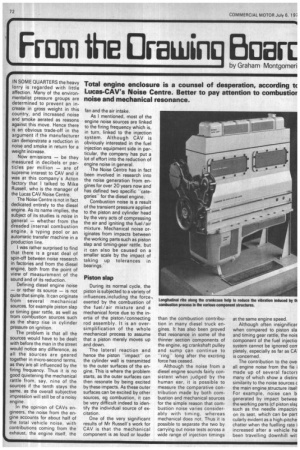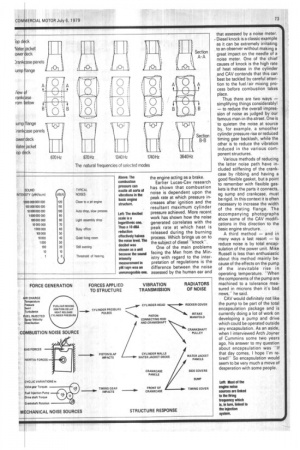From the I railing BOBIE
Page 74

Page 75

If you've noticed an error in this article please click here to report it so we can fix it.
by Graham Montgomen
Total engine enclosure is a counsel of desperation, according tc Lucas-CAV's Noise Centre. Better to pay attention to combustior noise and mechanical resonance.
IN SOME QUARTERS the heavy lorry is regarded with little affection. Many of the environmentalist pressure groups are determined to prevent an increase in gross weight in this country, and 'increased noise and smoke aerated as reasons against this move. Hence there is an obvious trade-off in the argument if the manufacturer can demonstrate a reduction in noise and smoke in return for a weight increase.
Now emissions — be they measured in decibels or particles per million — are of supreme interest to CAV and it was at this company's Acton factory that I talked to Mike Russell, who is the manager of the Lucas CAV Noise Centre.
The Noise Centre is not in fact dedicated entirely to the diesel engine. As its name implies, the subject of its studies is noise in general — whether from the dreaded internal combustion engine, a typing pool or an automatic transfer machine in a production line.
I was rather surprised to find that there is a great deal of spin-off between noise research in factories and from the diesel engine, both from the point of view of measurement of the sound and of its reduction.
Defining diesel engine noise — or rather its source — is not quite that simple. It can originate from several mechanical sources, for example piston slap or timing gear rattle, as well as trom combustion sources such as the sharp rise in cylinder pressure on ignition.
The problem is that all the sources would have to be dealt with before the man in the street would notice any difference, as all the sources are geared together in micro-second terms, as they are all influenced by the firing frequency. Thus it is no good quietening the mechanical rattle from, say, nine of the sources if the tenth stays the same, as the overall subjective impression will still be of a noisy engine.
In the opinion of CAVs engineers, the noise from the engine accounts for about half of the total vehicle noise, with contributions coming from the exhaust, the engine itself, the fan and the air intake.
As I mentioned, most of the engine noise sources are linked to the firing frequency which is, in turn, linked to the injection system. Although CAV is obviously interested in the fuel injection equipment side in particular, the company has put a lot of effort into the reduction of engine noise in general.
The Noise Centre has in fact been involved in research into the noise generation from engines for over 20 years now and has defined two specific "categories" for the diesel engine.
Combustion noise is a result of the transient pressure applied to the piston and cylinder head by the very acts of compressing the air and igniting the fuel/air mixture. Mechanical noise originates from impacts between the working parts such as piston slap and timing-gear rattle, but it can also be caused on a smaller scale by the impact of taking up tolerances in bearings.
Piston slap
During its normal cycle, the piston is subjected to a variety of influences,including the force.. exerted by the combustion of the fuel! air mixture and a mechanical force due to the inertia of the piston /connecting rod assembly. It is an oversimplification of the whole mechanical process to assume that a piston merely moves up and down.
The lateral reaction and hence the piston "impacton the cylinder wall is transmitted to the outer surfaces of the engine. This is where the problem starts, as the outer surfaces can then resonate by being excited
by these impacts. As these outer surfaces can be excited by other sources, eg combustion, it can be very difficult indeed to identify the individual source of excitation.
One of the very significant results of Mr Russell's work for CAV is that the mechanical component is as loud or louder
than the combustion contribution in many diesel truck engines. It has also been proved that resonance in some of the thinner section components of the engine, eg crankshaft pulley and sump can continue to -ringlong after the exciting force has ceased.
Although the noise from a diesel engine sounds fairly consistent when judged by the human ear, it is possible to measure the comparative contribution made by both combustion and mechanical sources for the simple reason that combustion noise varies considerably with timing. whereas mechanical does not. Thus it is possible to separate the two by carrying out noise tests across a wide range of injection timings at the same engine speed.
Although often insignificar when compared to piston sla and timing gear rattle, the nois component of the fuel injectio system cannot be ignored corr pletely, especially as far as CA' is concerned.
The contribution to the ove all engine noise from the fie i made up of several factors many of which show a distinc similarity to the noise sources c the main engine structure itsel. For example, noise can b generated by impact betwee the working parts (cf piston slar such as the needle impactiri. on its seat, which can be part cularly evident as a high-pitche chatter when the fuelling rate i increased after a vehicle ha been travelling downhill wit
the engine acting as a brake.
Earlier Lucas-Cav research has shown that combustion noise is dependent upon the peak rate at which pressure increases after ignition and the resultant maximum cylinder pressure achieved. More recent work has shown how the noise generated correlates with the peak rate at which heat is released during the burning process. Which brings us on to the subject of diesel "knock".
One of the main problems facing the Men from the Ministry with regard to the interpretation of regulations is the difference between the noise assessed by the human ear and that assessed by a noise meter. Diesel knock is a classic example as it can be extremely irritating to an observer without making a great impact on the needle of a noise meter. One of the chief causes of knock is the high rate of heat release in the cylinder and CAV contends that this can best be tackled by careful attention to the fuel /air mixing process before combustion takes place.
Thus there are two ways — simplifying things considerably! — to reduce the overall impression of noise as judged by our famous man-in-the-street. One is to quieten the noise at source by, for example, a smoother cylinder pressure rise or reduced timing gear backlash, while the other is to reduce the vibration induced in the various component structures.
Various methods of reducing the latter noise path have included stiffening of the crankcase by ribbing and having a good flexible gasket, but a point to remember with flexible gaskets is that the parts it connects, eg sump and crankcase, must be rigid. In this context it is often necessary to increase the width of the mating flange. The accompanying photographs show some of the CAV modifications in this direction to the basic engine structure.
A third method — and in many ways a last resort — to reduce noise is by total encapsulation of the power unit. Mike Russell is less than enthusiastic about this method mainly because of the effects on the pump of the inevitable rise in operating temperature. When the components of the pump are machined to a tolerance measured in microns then it's bad news," he said.
CAV would definitely not like the pump to be part of the total encapsulation package and is currently doing a lot of work on developing a pump and drive which could be operated outside any encapsulation. As an aside, when I interviewed Arch Joyner of Cummins some two years ago, his answer to my question about encapsulation was "If that day comes, I hope I'm retired!" So encapsulation would seem to be very much a move of desperation with some people.




























































































































